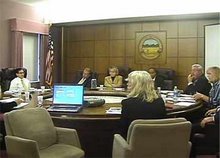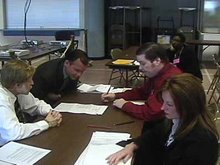First it should be understood thatwhatever that 3% sample of ballots and precincts is, is what the public cansee and recount - human eye and hand (even when there's alot of secret machinecode on either end which makes the process almost useless as a true "recount"of checking the voters' will. Without seeing the machine code telling thosemachines HOW to "count", we never can be sure what we're seeing is what thevoters' intended. However...)
Second, the rule is that if the 3% sample'shand count does not match up completely with the machine count (almost impossibleif one is just checking software-driven, coded memory card print-outs againstwhat all those same memory cards added up to in the tabulator) then a fullhand count of all precincts involved in the recount must ensue. The latteris a very time-consuming, labor intensive process....and can be a very revelatoryone, as one can see all the ballots and election data involved from the election.Also important.
At the very least, it's usually not something mostBOE's want to spend their Christmas or Thanksgiving doing...from say a November'08 presidential election.
In the requested and additionally paid-forOhio statewide county recounts from November, 2004, (the still highly questionedelection, for many well-documented but little reported reasons, of the 118,000margined Ohio Bush "win") many counties went out of their ways to make sure the 3% hand count matched.
Theirbiggest fear was a full countywide hand count - apparently both for time/laborreasons; and as documented evidence gathered over the past three years clearlyshows, in some cases for cover-up reasons too.
It was reported by the majority of 2004 recount observers throughout Ohio, and in the FreePressas one example of reports, that many counties preselected the recount precinctsin order to avoid having the 3% be random and to not match. That particular12/31 story, "Ohio's official non-recount ends amidst new evidence of fraud, theft..." went on to explain that the experts for an election challenge suit "have noted many of the precincts selected were mostly free of the irregularities they are seeking to investigate, while many contested precincts were left unrecounted." The story also reports that "InShelby County, election officials admitted that they discarded crucial tabulatorrecords, rendering a meaningful recount impossible."
Also,instead of pre-selection, some other reported methods occurred to avoid afull hand count. In Hocking County, Sherole Eaton, the now fired BOE deputydirector and Congressional whistleblower, sworean affidavit against a Triad company technician for allegedly offering acheat sheet and replacing the county’s central voting tabulator hard driveduring last year’s presidential recount, to make sure the sample hand count and tabulator matched. The same Triad actions were reported in at least one other county.
According to Truthout's 12.12/04 story, "Conyers Alarmed at Efforts to Obstruct Ohio Recount Effort, Calls Witness to Monday Hearing to Detail Such Efforts"
Yesterday,it came to the attention of the House Judiciary Committee Democratic Staffthat efforts to audit poll records in Greene County, Ohio are being obstructedby County Election officials and/or Ohio Secretary of State Ken Blackwell.According to Joan Quinn and Eve Robertson, two election observers researchingvoting records, Greene County officials initially gave Quinn and Robertsonaccess to poll records, and then abruptly withdrew such access. Greene CountyDirector of Elections Carole Garman claimed that she had withdrawn accessto the voting records at the direction of Secretary Blackwell. Regardlessof who ordered the denial of this access, such an action appears to violateOhio law. Later, at the same office, election observers found the officeunlocked, and what appeared to be locked ballot boxes, unattended. Priorto the withdrawal of access to the books, observers had found discrepanciesin election records, and possible evidence of minority vote suppression.
Richard Hayes Phillips, PhD. one of the Ohio 2004 election researchers, who's "seen it all," and was referred to in the above FreePress article, responded to this Directive 07-30 by saying:
Brilliant! So all that the election riggers have to do to avoid getting caught is toleave alone the first precinct in every political subdivision (e.g. wardor village) and rig everything else!See his provided excerpts on Clermont Recount, from RHP's upcoming book: "Witness to a Crime: A Citizens' Audit of an American Election."
This reminds me of Clermont County2004, where the markings on the "absentee" and "provisional" ballots showedthat the Board of Elections had decided before November 2, 2004which precincts would be hand counted if a recount should prove necessary. And it just so happens that Kerry performed significantly better in theseprecincts than he did in the rest of the county.
To be fair, Secretary Brunner's Directive 2007-30 was issued on November 16, 2007, ten days after the election. Assuming that no one got wind of her proposal in advance, then elections would not have been rigged in accordance with it. One hopes that a different directive will be issued after the next election, with different instructions for "random" selection of precincts to be recounted, and that the terms of the directive will be a closely guarded secret until the moment it is issued.
In Cuyahoga the criminal charges upon which the two CCBOE workers were charged and convicted, (and who since on another inside deal have been put into a "Diversion Program" to get their records expunged,) involved pre-counting the pre-selected 3%, hand to make sure they would match.
To paraphrase Jason Parry, an astute, articulate Ohio election reform activist:
"Wedon't need to talk about what-ifs and rigging. We already know that somecounties will do anything they can to "help" that 3% hand count match up.This "random" recount Directive allows counties to know which precincts mightbe part of the 3%. This allows counties to have less-than-honest recounts,like we saw in 2004. It also allows good intentioned counties to skirt theintention of a recount."
And thanks also to Jason for his heads up about the new report just released from a year and a half long study by professors at OSU's Moritz College of Law, where they said Ohio had "the most significant problems" of five Midwestern states studied.
There on page 38 in Chapter 3 about Ohio's Election Ecosystem: A Poster Child for Reform,( the chapter's download page 18) it states regarding the above-stated electiondata, including the majority of NON-randomly selected recount ballots:
"Anotherfederal court suit, King Lincoln Bronzeville Neighborhood Association v.Blackwell,76 argues that problems in the 2004 election in Ohio had a disproportionateimpact on some voters, and specifically alleges that election resources wereallocated in a racially discriminatory matter. This suit, which also seeksto put supervision of Ohio elections in the hands of a federal judge, isbeing held in abeyance pending settlement efforts.
Inan alarming development in this case, in the summer of 2007 the Ohio Secretaryof State's office disclosed that almost two-thirds of Ohio's counties hadfailed to comply with the federal court's order to retain their ballots andother records from the 2004 presidential election while this litigation proceeded. Althoughthe plaintiffs in the suit have suggested that at least some of these recordsmay have been intentionally destroyed to conceal irregularities, even theinadvertent loss or destruction of these ballots and other materials, contraryto court order, is extremely serious. It also appears to be emblematicof the difficulties that some local jurisdictions have had in following establishedrules and procedures."
Itis the activist research into the above facts that brought this serious non-compliancewith retention laws, by then in the realm of possible concealment of trialevidence, to light; it was the lack of SoS acknowlegement, or any consequencesto such local BOE non-compliance and law breaking, which prompted the formationof the Ohio Election Justice Campaign (OEJC), now a nationwide group.
Theybegan with asking for a meeting with Brunner, which she denied for months;held a funeral procession in downtown Columbus mourning the death of democracyon the anniversary of 2004's November 2 election, and asked Brunner to comeout and speak with them, which no one did; held a "Throw the Turkeys Out"day around Thanksgiving; a later press conference; a community teach-in;and they've delivered lawsuits from other states about the recall of electronicvoting machines - all without substantive response from SoS Brunner.
The PD also covered the Moritz study today.
Bottomline, any activist called into huge concern over the multitude of "irregularities"in the 2004 election, one which still has honest people from all partiesconcerned about loss of a fair, open election process, more than partisanship- and suspecting that Ohio was not won by Bush, (and most probably Forida 2000 was not either) - absolutely knows that if a recount is to be done by 3% sample first, that sample must be a valid representation of the ballots cast - which means a truly RANDOM selection.






No comments:
Post a Comment